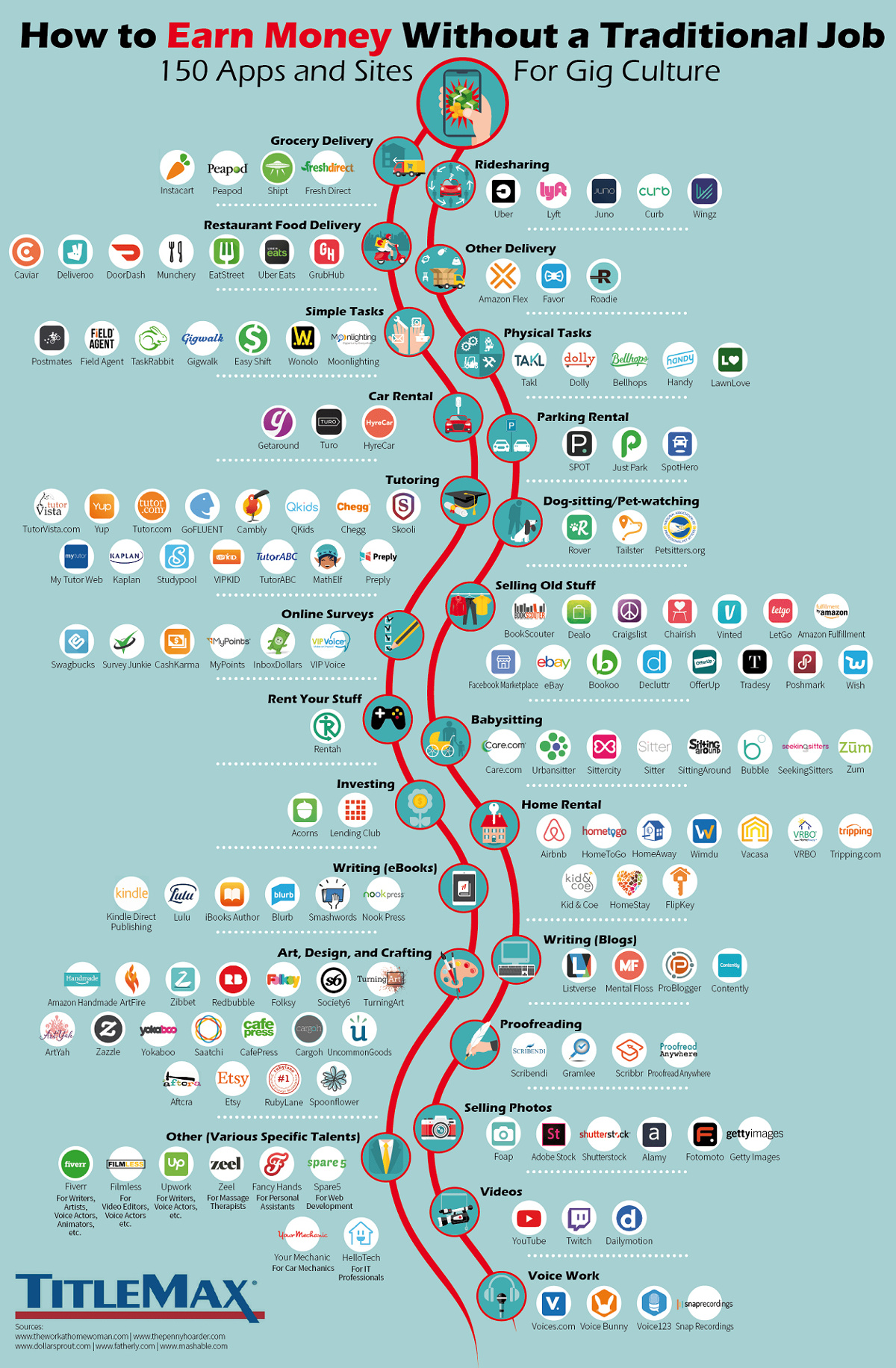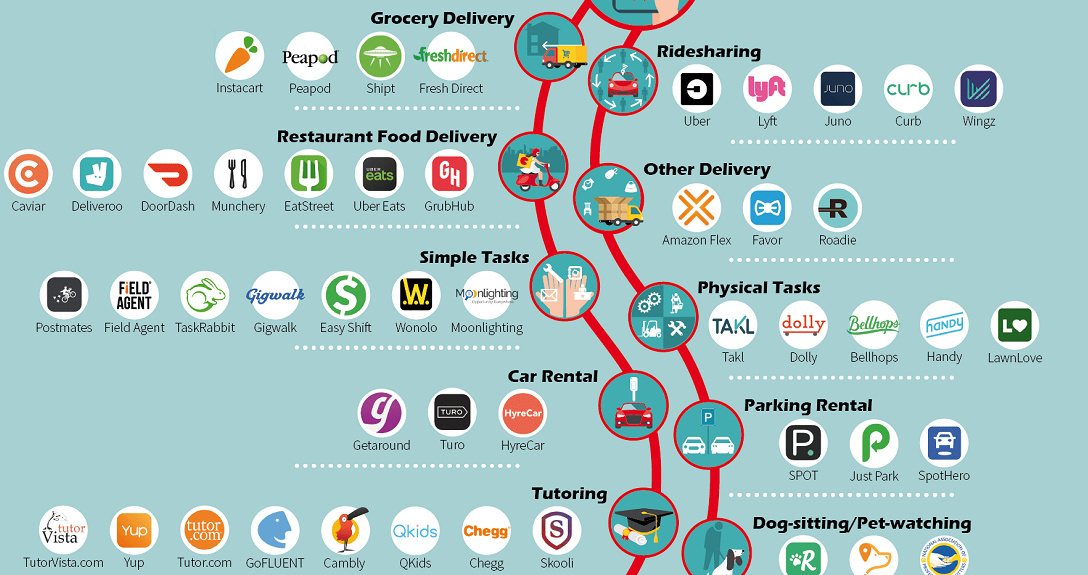Technology
The 150 Apps that Power the Gig Economy

Here are 150 Apps that Power the Gig Economy
Go back in time a decade, and you’d have a tough time convincing anyone that they would be “employed” through an app on their phone.
And yet, in a short period of time, the emergence of the smartphone has enabled the gig economy to flourish into a multi-trillion dollar global market. And by leveraging apps like Uber, Airbnb, and Etsy, it’s estimated that 57 million people in the U.S. now participate in the gig economy each year in some shape or form.
What apps do these people use to turn their time, skills, hobbies, or assets (cars, home, parking spaces, etc.) into additional income streams?
App Examples
Today’s infographic comes to us from TitleMax, and it lists 150 different apps that are used within the gig economy – including many that pay gig workers directly.
Here are just some of the apps that are used in some of the major categories above:
Ridesharing
Uber and Lyft are what many think of when they hear about the gig economy. However, there are now dozens of rideshare apps out there to fill different niches – for example, Wingz offers flat-fee rides to the airport, while Curb connects riders with professional taxi drivers.
Errands
TaskRabbit, which was bought by IKEA, turns errands such as assembling furniture or cleaning a gutter into payable gigs. Meanwhile, apps like Dolly and Bellhops will connect you with movers, and LawnLove is for lawn care.
Art, Design, and Crafting
Etsy, a marketplace for handmade goods, is one the of the best known brands in this category. However, there are many other niche options here as well – for example, UncommonGoods specializes in unique gifts, while Society6 focuses on gallery quality art prints.
Writing and Editing
Lulu and Kindle Direct allow you to publish eBooks online and sell them, while proofreaders and editors can get paid for their copy editing services through Gramlee.
Delivery
Fast and efficient delivery services are a centerpiece to the gig economy, and there are no shortage of options here. DoorDash, UberEats, Caviar, and GrubHub allow users to get food delivered to their doors, while apps like Instacart focus on grocery delivery.
Multimedia
We all know that you can create videos and monetize them on places like YouTube or Twitch, but did you know you can be a voice actor through services like VoiceBunny? You can also sell rights to your photos via Foap, or do freelancing work through Upwork or Fiverr.
Whether you are tapping into the gig economy for an extra income stream or you are incorporating gig economy services into your life for added convenience, there is no shortage of options to choose from.
Technology
Ranked: Semiconductor Companies by Industry Revenue Share
Nvidia is coming for Intel’s crown. Samsung is losing ground. AI is transforming the space. We break down revenue for semiconductor companies.
Semiconductor Companies by Industry Revenue Share
This was originally posted on our Voronoi app. Download the app for free on Apple or Android and discover incredible data-driven charts from a variety of trusted sources.
Did you know that some computer chips are now retailing for the price of a new BMW?
As computers invade nearly every sphere of life, so too have the chips that power them, raising the revenues of the businesses dedicated to designing them.
But how did various chipmakers measure against each other last year?
We rank the biggest semiconductor companies by their percentage share of the industry’s revenues in 2023, using data from Omdia research.
Which Chip Company Made the Most Money in 2023?
Market leader and industry-defining veteran Intel still holds the crown for the most revenue in the sector, crossing $50 billion in 2023, or 10% of the broader industry’s topline.
All is not well at Intel, however, with the company’s stock price down over 20% year-to-date after it revealed billion-dollar losses in its foundry business.
| Rank | Company | 2023 Revenue | % of Industry Revenue |
|---|---|---|---|
| 1 | Intel | $51B | 9.4% |
| 2 | NVIDIA | $49B | 9.0% |
| 3 | Samsung Electronics | $44B | 8.1% |
| 4 | Qualcomm | $31B | 5.7% |
| 5 | Broadcom | $28B | 5.2% |
| 6 | SK Hynix | $24B | 4.4% |
| 7 | AMD | $22B | 4.1% |
| 8 | Apple | $19B | 3.4% |
| 9 | Infineon Tech | $17B | 3.2% |
| 10 | STMicroelectronics | $17B | 3.2% |
| 11 | Texas Instruments | $17B | 3.1% |
| 12 | Micron Technology | $16B | 2.9% |
| 13 | MediaTek | $14B | 2.6% |
| 14 | NXP | $13B | 2.4% |
| 15 | Analog Devices | $12B | 2.2% |
| 16 | Renesas Electronics Corporation | $11B | 1.9% |
| 17 | Sony Semiconductor Solutions Corporation | $10B | 1.9% |
| 18 | Microchip Technology | $8B | 1.5% |
| 19 | Onsemi | $8B | 1.4% |
| 20 | KIOXIA Corporation | $7B | 1.3% |
| N/A | Others | $126B | 23.2% |
| N/A | Total | $545B | 100% |
Note: Figures are rounded. Totals and percentages may not sum to 100.
Meanwhile, Nvidia is very close to overtaking Intel, after declaring $49 billion of topline revenue for 2023. This is more than double its 2022 revenue ($21 billion), increasing its share of industry revenues to 9%.
Nvidia’s meteoric rise has gotten a huge thumbs-up from investors. It became a trillion dollar stock last year, and broke the single-day gain record for market capitalization this year.
Other chipmakers haven’t been as successful. Out of the top 20 semiconductor companies by revenue, 12 did not match their 2022 revenues, including big names like Intel, Samsung, and AMD.
The Many Different Types of Chipmakers
All of these companies may belong to the same industry, but they don’t focus on the same niche.
According to Investopedia, there are four major types of chips, depending on their functionality: microprocessors, memory chips, standard chips, and complex systems on a chip.
Nvidia’s core business was once GPUs for computers (graphics processing units), but in recent years this has drastically shifted towards microprocessors for analytics and AI.
These specialized chips seem to be where the majority of growth is occurring within the sector. For example, companies that are largely in the memory segment—Samsung, SK Hynix, and Micron Technology—saw peak revenues in the mid-2010s.
-

 Real Estate2 weeks ago
Real Estate2 weeks agoVisualizing America’s Shortage of Affordable Homes
-

 Technology1 week ago
Technology1 week agoRanked: Semiconductor Companies by Industry Revenue Share
-

 Money1 week ago
Money1 week agoWhich States Have the Highest Minimum Wage in America?
-

 Real Estate1 week ago
Real Estate1 week agoRanked: The Most Valuable Housing Markets in America
-

 Business2 weeks ago
Business2 weeks agoCharted: Big Four Market Share by S&P 500 Audits
-

 AI2 weeks ago
AI2 weeks agoThe Stock Performance of U.S. Chipmakers So Far in 2024
-

 Misc2 weeks ago
Misc2 weeks agoAlmost Every EV Stock is Down After Q1 2024
-

 Money2 weeks ago
Money2 weeks agoWhere Does One U.S. Tax Dollar Go?














